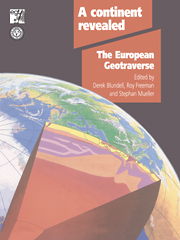5 - EUROPE'S LITHOSPHERE – RECENT ACTIVITY
Published online by Cambridge University Press: 05 November 2009
Summary
A variety of studies and data compilations to obtain information about the state of geodynamic activity of the lithosphere both now and in the recent past have been carried out along EGT. Knowledge of the present state of activity is of critical importance for understanding modern tectonic development, and for geodynamic processes that have been operating in the past.
In this chapter we discuss observational evidence on recent activity in the lithosphere of Europe along and adjacent to the EGT swathe as revealed from seismicity information (given in EGT Atlas Maps 3 and 4), including focal depths and focal mechanisms (EGT Atlas Map 5), state of stress in the lithosphere (EGT Atlas Map 6), recent crustal movements, active volcanism and transient heat flow. We discuss dynamic activity in relation to tectonic units, the state of stress both regionally and locally, and seek explanations in terms of present-day and recent dynamic processes within the lithosphere and in the lithosphere–asthenosphere system.
Since EGT encompasses a wide variety of tectonic provinces from the old Archean and Proterozoic Baltic Shield to the young active Alpine–Mediterranean system, present-day dynamics has to be viewed and interpreted in terms of different processes acting on a variety of different structures. In the southern part of Europe the present state of dynamic activity clearly reflects active tectonic processes including lithospheric continental collision, extension and subduction. In the north, old, mature lithosphere has been subject to glacial loading and unloading and is influenced by plate tectonic processes in the north Atlantic.
- Type
- Chapter
- Information
- A Continent RevealedThe European Geotraverse, Structure and Dynamic Evolution, pp. 111 - 138Publisher: Cambridge University PressPrint publication year: 1992
- 1
- Cited by



